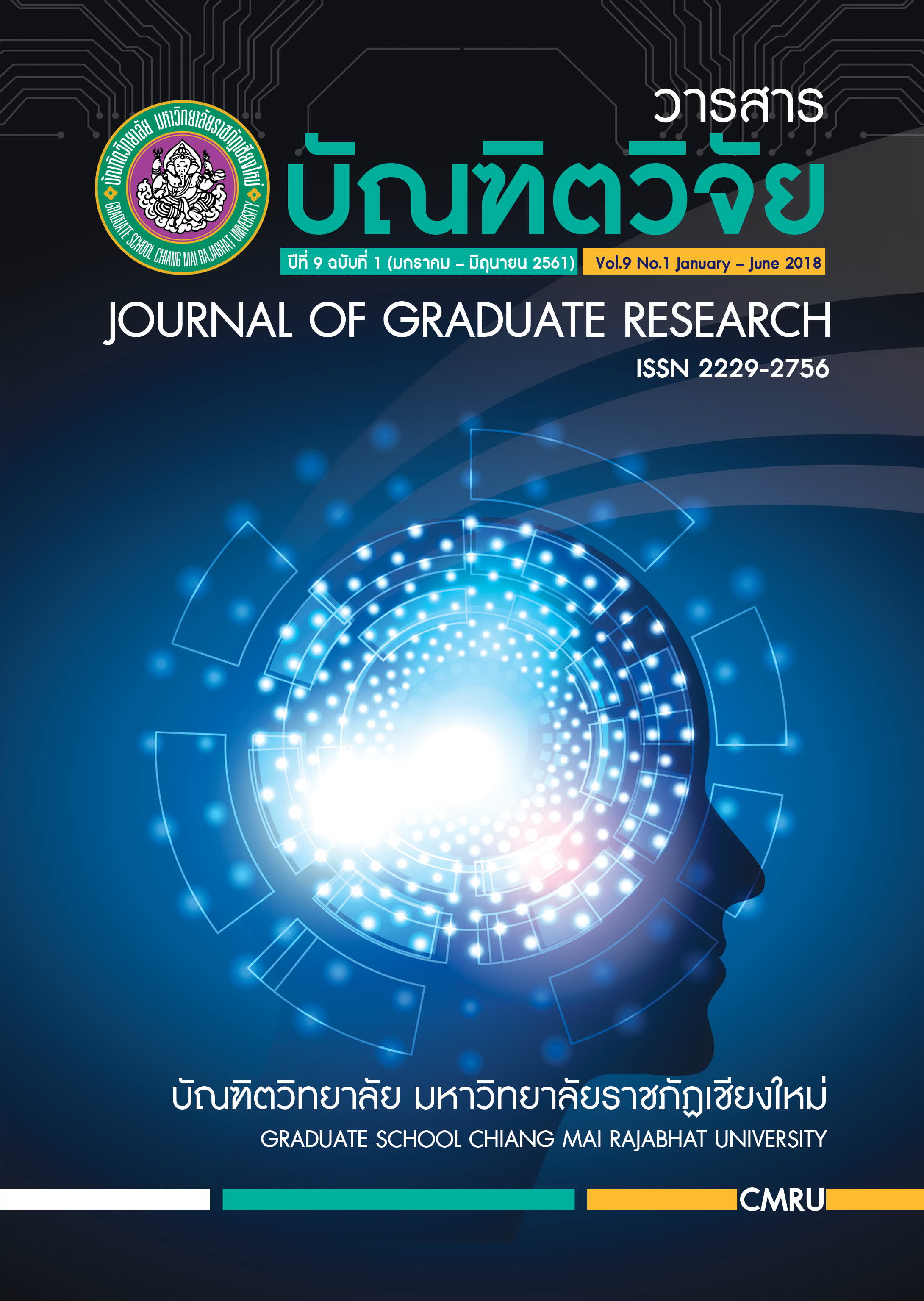Homestay and Sustainable Tourism Management in Nan Province -
Main Article Content
Abstract
The purposes of this research were 1) to study the tourism management of homestays in Nan Province, 2) to analyze the potential of tourism management in the province and 3) to examine a guideline to manage sustainable tourism of homestays related to lifestyles of the communities. This research was a mixed-method in which the quantitative data was collected from questionnaires distributed to 45 community homestay entrepreneurs, and was statistically analyzed for frequency, percentage, means, and standard deviation. By means of qualitative data, observation and preliminary interview sessions were concucted. Sets of interview questions were operated with the samples: non-entrepreneur residents living in the participating communities, selected by using a purposive sampling method from 3 communities; 10 people each with a total of 30 participants. Furthermore, an in-depth interview session was conducted with 8 participants. The collected qualitative data was analyzed by using a content analysis.
The results were that the communities managed eco-tourism in 7 aspects: 1) an access to tourism areas of homestays, 2) accommodation of tourists, 3) food for tourists,
4) activities and tourist guides, 5) resources and environment, 6) public relations and promotion, and 7) management of homestay groups. Moreover, the homestay entrepreneurs emphasized management of homestays at a high level. When considering in the aspects, ranked from high to low, it was found that the top-three aspects were food for tourists, accommodation of tourists, and management of homestay groups, respectively. In terms of the potential of tourism management of homestays using a market opportunity analysis, the results were that the strengths of homestay groups included 1) high-leadership performance of group leaders, 2) clear segregation of duties of group operations, 3) various tourism activities, 4) attractive natural resources, and 5) safety. The weaknesses were 1) communication with foreigners, 2) lack of local tour guides, 3) lack of operating budget, and 4) insufficient accommodation. By means of opportunities, the results involved 1) popularity of eco-tourism, 2) certification of Thai homestays, and 3) Tai Lue lifestyle. For the threats, the results included 1) more competitions in tourism businesses in the province, 2) lack of continuous supports, and 3) inconvenient routes and transportation to the communities.
For the guideline to manage sustainable tourism of homestays, the results involved a development of community potential, raising consciousness in resource conservation, group leaders, public relations, income distribution to local people and a balance between tourist needs, needs of local communities, and resource capabilities.
Article Details
References
กัลยา วานิชย์บัญชา. (2551). การใช้ SPSS for Windows ในการวิเคราะห์. (พิมพ์ครั้งที่ 11). กรุงเทพฯ: ธรรมสาร.
ฉัตรฆฤน พิชัยกมลฉัตร. (2550). การประเมินศักยภาพและการวิเคราะห์แหล่งท่องเที่ยวในจังหวัดนนทบุรี. (วิทยานิพนธ์อักษรศาสตร์มหาบัณฑิต, สาขาวิชาภูมิศาสตร์ จุฬาลงกรณมหาวิทยาลัย).
ธีระ อินทรเรือง. (2559). การวางแผนพัฒนาและการจัดการท่องเที่ยวอย่างยั่งยืน. เอกสารประกอบการสอน, มหาวิทยาลัยราชภัฏสวนสุนันทา.
ประสพชัย พสุนนท์. (2555). การวิจัยการตลาด. กรุงเทพฯ: ท้อป.
ปรารถนา ยศสุข และ เฉลิมชัย ปัญญาดี. (2548). ผลกระทบของการท่องเที่ยวเชิงนิเวศต่อชุมชนและครัวเรือนในชุมชนที่มีการท่องเที่ยวเชิงนิเวศในชนบทภาคเหนือของประเทศไทย. เชียงใหม่: วิทยาลัยบริหารศาสตร์ สาขาวิชาบริหารศาสตร์ มหาวิทยาลัยแม่โจ้.
พิมพ์ลภัส พงศกรรังศิลป์. (2557). การจัดการการท่องเที่ยวชุมชนอย่างยั่งยืน: กรณีศึกษาบ้านโคกไทร จังหวัดพังงา. วารสารวิชาการ ฉบับมนุษยศาสตร์ สังคมศาสตร์ และศิลปะ, 7(3), 650-665.
ภราเดช พยัฆวิเชียร. (2550). การท่องเที่ยวเชิงวัฒนธรรมรากหญ้าโดยชุมชนในประเทศไทย. กรุงเทพฯ: การท่องเที่ยวแห่งประเทศไทย.
รำไพพรรณ แก้วสุริยะ. (2545). การจัดการท่องเที่ยวชุมชนอย่างยั่งยืน. เอกสารประกอบการบรรยาย โครงการเผยแพร่ความรู้ด้านการท่องเที่ยวผ่านเวปไซต์, มหาวิทยาลัยสุโขทัยธรรมาธิราช.
วีระศักดิ์ กราปัญจะ. (2554). รูปแบบการจัดการการท่องเที่ยวเชิงนิเวศในพื้นที่ป่าชุมชนบ้านอ่าวท่าเลน-บ้านท่าพรุ ตำบลเขาทอง อำเภอเมือง จังหวัดกระบี่. (การศึกษาอิสระ ปริญญามหาบัณฑิต, มหาวิทยาลัยสุโขทัยธรรมาธิราช).
สันติชัย เอื้อจงประสิทธิ์. (2549). การบริหารท่องเที่ยวเชิงกลยุทธ์. กรุงเทพฯ: สามเจริญพาณิชย์.
สำนักพัฒนาการท่องเที่ยว. (2552). มาตรฐานโฮมสเตย์ไทย Homestay Standard Thailand พ.ศ. 2551. (พิมพ์ครั้งที่ 4). กรุงเทพฯ: โรงพิมพ์แห่งจุฬาลงกรณ์มหาวิทยาลัย.
สำนักพัฒนาเศรษฐกิจและสังคมภาคตะวันออกเฉียงเหนือ. (2556). การท่องเที่ยวเชิงนิเวศอย่างยั่งยืนบนเส้นทางสีเขียวกรณีพื้นที่ภาคตะวันออกเฉียงเหนือ. รายงานผลการวิจัยฉบับสมบูรณ์. กรุงเทพฯ: สำนักงานคณะกรรมการพัฒนาการเศรษฐกิจและสังคมแห่งชาติ.

